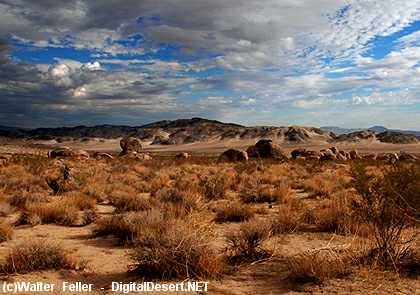
The transition from the hot Sonoran Desert to the cooler and higher Great Basin is called the Mojave Desert. This arid region of southeastern California and portions of Nevada, Arizona and Utah, occupies more than 25,000 square miles.
Situated between the Great Basin Desert to the north and the Sonoran to the south (mainly between 34 and 38°N latitudes), the Mojave, a rainshadow desert, is defined by a combination of latitude, elevation, geology, and indicator plants.
Elevations are generally between three and six thousand feet, although Death Valley National Park includes both 11,049-foot Telescope Peak and the lowest point in the United States 282 feet below sea level at Badwater.
Temperatures are a function of both latitude and altitude. Although the Mojave Desert has the lowest absolute elevation and the highest maximum temperature (134°F in Death Valley), it is north of the Sonoran Desert and its average elevations are higher. As a result, its average temperatures are lower than those of the Sonoran.
The Mojave has a typical mountain-and-basin topography with sparse vegetation. Sand and gravel basins drain to central salt flats from which borax, potash and salt are extracted. Silver, tungsten, gold and iron deposits are worked.
While some do not consider the Mojave a desert in its own right, the Mojave Desert hosts about 200 endemic plant species found in neither of the adjacent deserts.Cactus are usually restricted to the coarse soils of bajadas. Mojave Yucca and, at higher elevations Desert Spanish Bayonet, a narrow-leafed yucca, are prominent. Creosote Bush, Shadscale, Big Sagebrush, Bladder-sage, bursages and Blackbush are common shrubs of the Mojave Desert.
Occasional Catclaws grow along arroyos. But, unlike the Sonoran Desert, trees are few, both in numbers and diversity. The exception is the Joshua-tree. While this unusual tree-like yucca is usually considered the prime indicator of Mojave Desert vegetation, it occurs only at higher elevations in this desert and only in this desert.
No comments:
Post a Comment